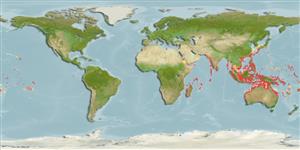Preferred temperature (Ref.
123201): 24.4 - 29, mean 27.6 °C (based on 1254 cells).
Phylogenetic diversity index (Ref.
82804): PD
50 = 0.5000 [Uniqueness, from 0.5 = low to 2.0 = high].
Bayesian length-weight: a=0.01023 (0.00477 - 0.02194), b=3.02 (2.84 - 3.20), in cm total length, based on LWR estimates for this (Sub)family-body shape (Ref.
93245).
Nivel trófico (Ref.
69278): 3.4 ±0.41 se; based on food items.
Resiliencia (Ref.
120179): Medio, población duplicada en un tiempo mínimo de 1.4-4.4 años (Preliminary K or Fecundity.).
Fishing Vulnerability (Ref.
59153): Low vulnerability (15 of 100).
Nutrients (Ref.
124155): Calcium = 59.9 [33.5, 106.4] mg/100g; Iron = 0.603 [0.321, 1.046] mg/100g; Protein = 18.6 [16.8, 20.3] %; Omega3 = 0.138 [0.068, 0.217] g/100g; Selenium = 27.6 [16.5, 48.3] μg/100g; VitaminA = 100 [30, 283] μg/100g; Zinc = 1.38 [0.98, 1.96] mg/100g (wet weight);
